Chapsa multicarpa Lücking, Parnmen & Lumbsch, in Ariyawansa et al., Fungal Diversity: 10.1007/s13225-015-0346-5, [108] (2015)
Index Fungorum number: IF551486; Facesoffungi number: FoF00968
Etymology – Referring to the usually aggregate ascomata.
Holotype – R. Lücking 24007 (RAMK).
Diagnosis – Differing from Chapsa leprocarpa and C. patens in the smaller, aggregate ascomata with layered excipulum. Thallus corticolous on tree trunks and branches, endoperidermal, continuous, smooth to uneven, following the contours of the bark, brownish to greenish depending on bark type, opaque. Photobiont endoperidermal, Trentepohlia; cells rounded to irregular in outline, in irregular groups, yellowish green, 6–12×5–10 μm. Sexual morph: Ascomata aggregated, groups erumpent, angular to elongate, 0.5–1.5 mm across, usually composed of 2–5 individual ascomata; individual ascomata angular-rounded, 0.2–0.3 mm diam. and 0.15–0.18 mm high; disc mostly covered by concentric layers of excipula, grey-brown, thickly white-pruinose; proper margin distinct, white, forming several excipular layers; thalline margin formed by shallow, erect lobules, pale yellowish. Columella absent. Excipulum paraplectenchymatous, 15–20 μm wide, hyaline, fused with thalline margin; thalline margin 40–70 μm thick; hypothecium prosoplectenchymatous, 15–20 μm high, hyaline; hymenium 130–150 μm high, hyaline, clear; epithecium with large crystal clusters, 20–30 μm high, grey. Paraphyses unbranched, smooth; lateral paraphyses up to 15μm long; asci ellipsoid to fusiform, 120–140×25–30 μm. Ascospores 1 per ascus, richly muriform, hyaline, ellipsoid to fusiform, with thin septa and rectangular lumina, 80–130×20–25 μm, I–. Asexual morph: Undetermined. Secondary chemistry: No substances detected by TLC.
Material examined – THAILAND, Nakhon Ratchasima, Khao Yai National Park, 200 km NE of Bangkok, Khao Keaw scenic lookout; 14° 22′ N, 101° 24′ E; 1140 m; tropical submontane moist evergreen forest dominated by
Dipterocarpaceae; 13 March 2008; R. Lücking 24007 (RAMK holotype; F isotype); same locality and date, R. Lücking 24009 (F paratype).
Notes – Chapsa multicarpa is characterized by the small ascomata aggregate in irregular to linear groups, containing two to five individual ascomata, with a layered excipulum and large, muriform ascospores occurring singly in each ascus. Molecular sequence data place the new species in Chapsa sensu stricto (Parnmen et al. 2012; Rivas Plata et al. 2013), unsupported sister to the type species, C. indica A. Massal. (Fig. 65). The large, single, muriform ascospores and the lack of secondary substances would key out C. multicarpa close to C. leprocarpa (Nyl.) Frisch and C. patens (Nyl.) Frisch (Rivas Plata et al. 2010), but both these species have larger, solitary ascomata and the excipulum is not layered. Molecular sequence data including mtSSU, nuLSU and RPB2 also show that all three species are phylogenetically distinct (Rivas Plata et al. 2013; Fig. 65). Chapsa multicarpa also resembles Astrochapsa kalbii Poengsungnoen et al. (2014), which also features aggregate ascomata with a layered excipulum. However, the latter forms an epiperidermal thallus with a thin, loose cortex, the hymenium is formed in the outermost ring of the concentric excipulumlayers (not in a central disc), and the ascospores are smaller (less than half the size) and with 1–2 per ascus. Phylogenetically, the two species are only distantly related, as A. kalbii is closely related to the type species of Astrochapsa, A. astroidea (Berk. & Broome) Parnmen et al. (2012; Poengsungnoen et al. 2014).

Fig. 1 Chapsa multicarpa (paratype) a Thallus surface view with ascomata. Chapsa multicarpa (holotype) b–d Thallus surface view with ascomata.
Fissurina carassensis (holotype) e, f Thallus surface view with ascomata. Scale bars: a–f=1 mm
